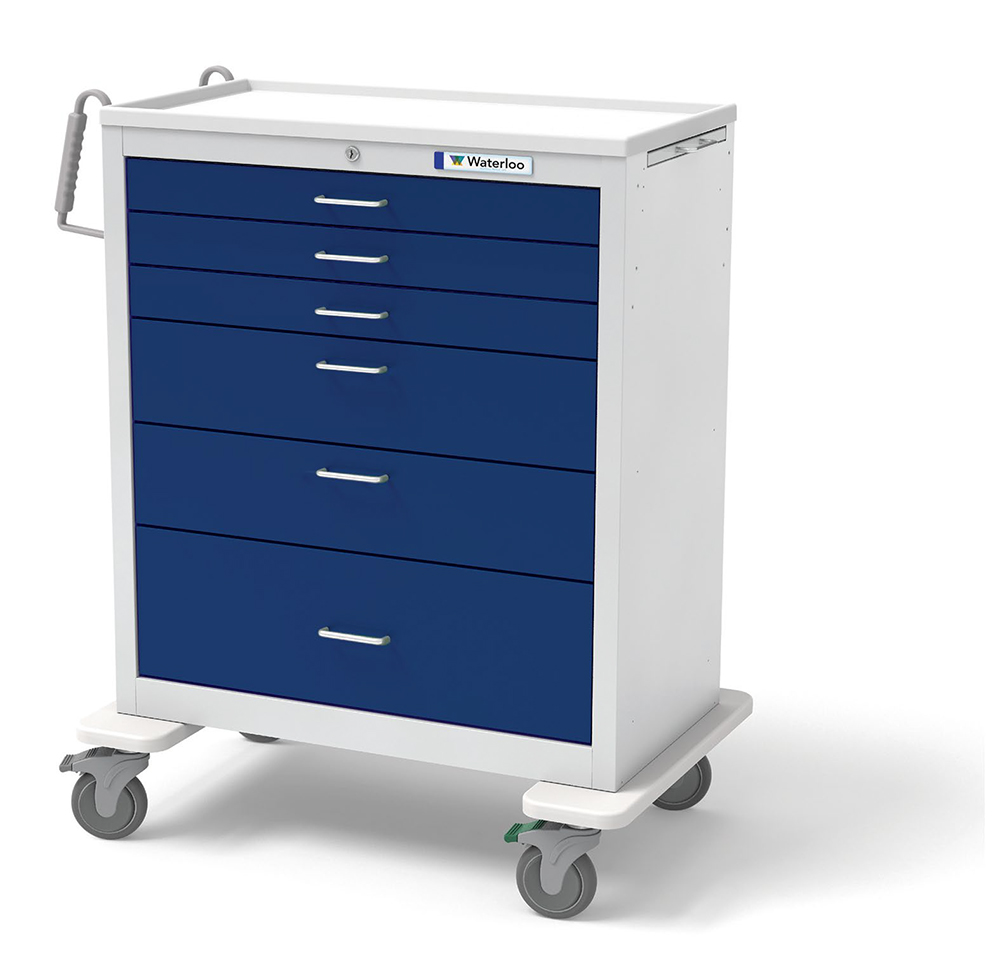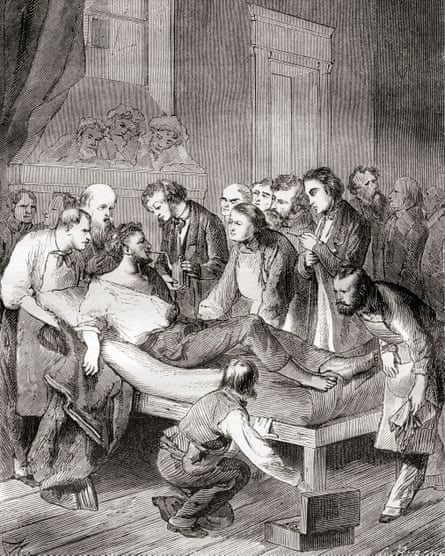
Anesthesia Carts
Last quarter we focused our attention on one of the most important procedure carts in a hospital: emergency carts. While no one can deny the importance of emergency carts, anesthesia carts also play a vital role in patient treatment, and we will focus our attention on them in this newsletter.
In recent years, we’ve seen not only an increased focus on the security of controlled substances on anesthesia carts, but an elevated cart inventory list based on the increased use of disposable equipment. These two criteria have driven several advances in lock options as well as overall anesthesia cart design. We will cover many of these improvements in the educational section of this newsletter.
As medical treatment advances, we are focused on offering product features that address these new requirements. From our dual credential lock options to our wider platform anesthesia carts, Waterloo Healthcare is committed to the constant improvement in our products and services.

Best Practices for Configuring an Anesthesia Cart
An anesthesia cart is a vital component of any healthcare facility, providing essential tools and medications for safe and efficient anesthesia administration and monitoring. Properly configuring an anesthesia cart is crucial to ensure patient safety, enhance workflow, and optimize the anesthesia team’s performance. The goal of this article is to highlight “best practices” for configuring an anesthesia cart including supply organization, medication management, equipment placement, and safety and security considerations.
Organization and Categorization
Effective organization is key to locating and retrieving supplies swiftly during critical moments. Categorize supplies into logical groupings such as airway equipment, medications, intravenous supplies, and monitoring devices. Within each category, employ consistent organization methods like color-coding, clear labels, or numerical systems. Utilize compartments, trays, and dividers to maintain an orderly arrangement of items, guaranteeing that they are easily visible and accessible. We highly recommend a regular review and updating the cart’s organization as needed to accommodate changes in procedures, technologies, or guidelines.
Consider going wider and not taller when upgrading your current anesthesia carts. In recent years, there has been a noticeable uptick in the use of disposable supplies by anesthesiologists during surgical procedures. This trend can be attributed to several factors. First and foremost, the emphasis on infection control and patient safety has prompted healthcare providers to prioritize the use of sterile, single-use items. Disposable supplies minimize the risk of cross-contamination and transmission of infectious agents in the operating room. Unfortunately though, the use of disposable items increases the required storage capacity of your anesthesia cart. Prior to the availability of a wider cart, your only choice was to source a taller cart to increase storage capacity, but a taller cart can put the cart’s top work surface out of reach for shorter clinicians. By going wider, you can preserve a comfortable work height while storing more supplies. We call this a “win-win” for all!

Medication Management
Proper management of medications within the anesthesia cart minimizes the risk of errors and ensures the availability of essential drugs. Implement a system for organizing medications that includes clear labels with generic and brand names, dosages, expiration dates, and any special storage requirements. Separate medications by type (induction agents, analgesics, muscle relaxants, etc.) to facilitate quick identification.
Regularly monitor and restock medications, discarding expired or damaged ones (and be sure to replace those that were removed). Incorporate a double-check process to verify medication accuracy and prevent mix-ups. Secure controlled substances in a lockable compartment, adhering to applicable regulations and maintaining a log of access and usage.
Adhering to controlled substance storage requirements on an anesthesia cart is crucial for patient safety. These medications, which come with a higher risk of abuse and diversion, must be stored securely in locked compartments. Only authorized personnel should have access, and the cart should be kept in a monitored environment. Consider dual credential locks that require two separate authorized numeric codes or employee badges to gain access to the controlled substance drawer. These strict storage measures for controlled substances prevent theft, ensure accurate administration, and safeguard against misuse or diversion, thereby enhancing patient care and safety.
Equipment Placement
Equipment Placement
Strategic placement of equipment on the anesthesia cart promotes efficiency and streamlines workflow. Arrange frequently used equipment (such as laryngoscopes, endotracheal tubes, and suction devices) within easy reach. Organize equipment based on the sequence of anesthesia administration to ensure a logical flow. For example, place airway devices and tools closer to the front of the cart, followed by intravenous supplies and monitoring devices. Utilize dividers or dedicated spaces for delicate items to prevent damage or contamination. Consider ergonomic factors, such as side shelves and easy-glide drawers, to minimize the risk of strain or injuries for anesthesia providers.
Safety Considerations
Anesthesia cart configuration must prioritize patient and staff safety. Ensure that the cart is designed to withstand the rigors of the healthcare environment, with sturdy construction and smooth edges. Implement safety features like locking mechanisms to prevent accidental spillage or unauthorized access. Incorporate proper waste management options within the cart, including sharps containers and biohazard bags, to facilitate safe disposal of used supplies. Regularly inspect the cart for any damaged or malfunctioning components and promptly address maintenance needs. Conduct routine cleaning and disinfection to maintain a sterile and infection-free environment.

Conclusion
Configuring an anesthesia cart according to best practices is vital for optimizing patient care and workflow efficiency. By implementing effective organization techniques, ensuring proper medication management, strategically placing equipment, and prioritizing safety considerations, healthcare facilities can enhance anesthesia delivery, reduce errors, and promote a safe environment for patients and healthcare providers alike.
Going Wide
Waterloo Wide Carts are now available with Dark Blue drawer fronts, one of our most requested colors for anesthesia carts. If storage space on your current cart is at a premium, we say “Why go taller when you can go wider?”
Going wider offers several advantages:
- More storage capacity – Drawers on our wide carts are 30% wider than standard procedure cart drawers, offering greater storage potential.
- Ergonomic work height – By going wider not taller, you effectively increase your storage capacity while maintaining a comfortable cart-top work surface.
- Better visual access to drawer contents – Wider drawers offer a broader view of drawer contents and can minimize the need to open several smaller drawers when searching for supply items.

Anesthesia… You’ve Come a Long Way, Baby!
It’s a normal, very human condition – anxiety and fear before a surgical procedure – just knowing it was going to happen, not knowing how it would feel after, and wondering about recovery and if it would be a success. Now combine that with not having any anesthesia, and not knowing exactly what to expect while you were awake during it but being absolutely certain that there was going to be pain during a period of time while the surgeon did his work with the primitive tools back then.
Yikes! Seriously… Can you imagine having surgery without general anesthesia? If not (and we sure can’t!), you should consider yourself lucky not to have been around just a couple hundred years ago. Anesthesia has come a long way since then, and we thought it would be appropriate in this newsletter to take a look back at how far medical science has come to provide patients with amnesia and comfort during surgery.
The earliest use of anesthesia could be in the 1200s when ancient peoples like the Greeks, Incas, Chinese, and Babylonians used opium- or mandragora-soaked sponges, hashish, or hemp for pain relief. Other than that, alcohol was used or a bullet was given to bite on (perhaps leading to needed dental work and even more primitive pain relief and suffering).

The most widely recognized use of a general anesthetic is considered to be in 1804 when Japanese physician Seishu Hanaoka performed a partial mastectomy on a 60-year-old female patient suffering from breast cancer. He utilized a mix of herbs, namely thorn apple and monkshood, that was taken internally (by drinking). The patient did survive the operation, but unfortunately passed away about 6 months post-op. Hanoaka trained over 2,000 students on his anesthesia technique, but his chosen method did not reach outside of Japan’s borders.
In the early 19th century, ether, a flammable and volatile liquid, was the first anesthetic to be widely accepted for use as general anesthesia for surgeries. It seemed to be more of an intoxicant though, and gained the favor of those opting for a substitution to whiskey or other alcoholic drinks, having so-called “ether frolics” instead of binge drinking. Medical and dental professionals who were in attendance at these gatherings in the 1840s realized that the sensation of pain was not felt when people were under the influence of ether. As many medical researchers of the time did, William Morton, a dentist in Boston, used ether on himself in experiments, and his findings led him to the conclusion that it would be a good option for his patients.
Nitrous oxide was already in use by this time, but that option and ether were not as quickly instituted by surgeons, most likely because dental patients didn’t need as prolonged relief and both substances were seen as safe and easier to administer in smaller doses.
Morton, in 1846, was on hand at Massachusetts General Hospital to participate in the inaugural display of ether being used as a general anesthetic. The surgery was successful and shortly thereafter, American and European surgeons realized the potential of ether to be used in their work. Ether was then pioneered by a Midwife Professor (James Young Simpson) to be used during childbirth. He also made the discovery of chloroform, which was given to Queen Victoria by Dr. John Snow as she gave birth to her two children, earning it the royal seal of approval. Chloroform was easier to use, so English surgeons made the shift to it, while American surgeons stayed with ether, as they believed it had fewer risks. Thankfully, by the turn of the 20th century, the use of general anesthesia enjoyed (as did patients who received it) acceptance.
Waterloo Healthcare is dedicated to providing quality, flexible medical cart solutions that accommodate any clinician’s needs, and our team is always available to help design the cart that’s right for you!






